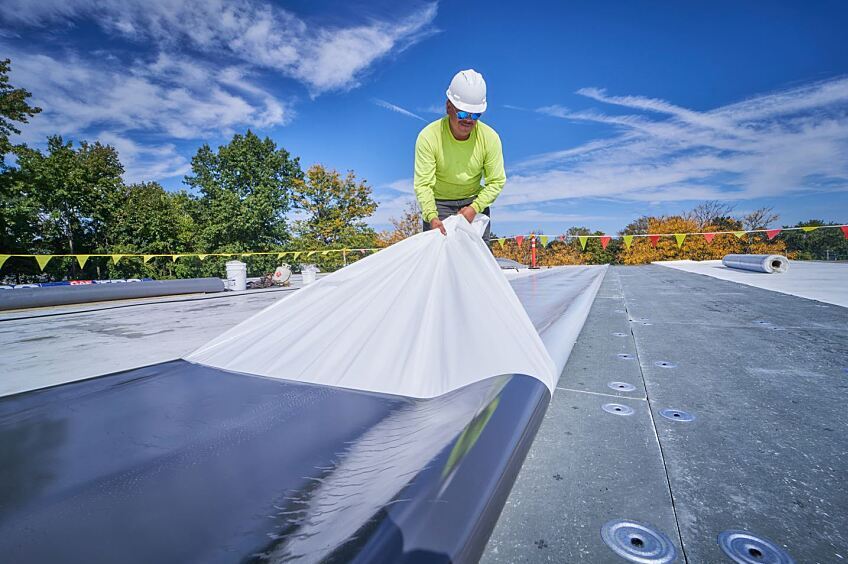With the labor pool stretched thin, finding time-saving products is high on many contractors' to-do lists. Saving time doesn't mean jeopardizing quality as manufacturers continually work to deliver solutions that help increase efficiency while still delivering a first-class installation.
To help contractors save time while still producing high-quality work, GAF offers several products that can help a commercial roofing business do more in less time.
1. How Long Does Spray Adhesive Take to Dry?
EverGuard® TPO Quick Spray Adhesive has a flash time of five minutes or less and can be applied 50% faster than traditional bucket and roller adhesive. When used properly, a single canister can cover the installation of approximately 10 squares, compared to the approximately three squares of installation a bucket can cover. (As with all adhesives, the substrate's porosity can impact coverage rates.)
Because it's a solvent-based adhesive, it's sprayable, allowing installers to quickly bond thermoplastic polyolefin (TPO) membrane to a variety of approved substrates. Simply spray it uniformly onto the substrate and the back of the membrane. Then, apply pressure with a broom or weighted roller to ensure adhesion and heat-weld the seams.
2. How Do TPO Accessories Save Time?
It can take a significant amount of time, experience, and know-how to properly measure, cut, and hand-weld details. GAF TPO accessories are available for most details of a rooftop, offering a full line of vent and pipe boots, tube wraps, pourable sealer pockets, and universal corners that can be cut to accommodate either an inside or outside corner.
When the accessory is ready to install with no field fabrication, you'll find that installers not only save time but also achieve consistent quality in all the flashings while boosting their productivity.
3. How Does Fabricated Edge Metal Save Time?
Fabricating edge metal in the field requires time and experience, not to mention the additional equipment needed to form the metal. GAF Perimeter Edge Metal saves hours of time in the field, and the coping, drip edges, fascia, and accessories are easy to install with features like prepunched holes to ensure the secure termination of the membrane.
Because all GAF edge metal is tested and compliant with the ANSI/SPRI ES-1, FM, Miami Dade, and Florida Building Code for IBC, you can have confidence in knowing that the most critical point on the roof—the perimeter—has the highest protection.
4. What Is a Self-Adhered Roofing System?
A self-adhered roofing system is up to 60% faster to install than a roof that is traditionally adhered. Self-adhered TPO eliminates the need to apply adhesive altogether. EverGuard® SA TPO Self-Adhered Roof Membrane comes with the adhesive already applied on the back of the membrane. Once positioned, the crew just folds the membrane sheet back, removes the release liner to expose the factory-applied adhesive, lays the membrane in place, and brooms in the sheet. The crew then uses a weighted roller and heat-welds the seams.
You not only save time during the installation, but you also save time cleaning up the jobsite as there are no buckets, rollers, or containers to dispose of.
5. How Does a Self-Adhered Vapor Barrier Work?
GAF SA Vapor Retarder XL relies on an advanced, high-tack butyl rubber adhesive and is self-sealing, resulting in three times the peel strength of modified bitumen self-adhered vapor barriers.
It also saves time right off the bat by eliminating the need for primer prior to installation. The large, six-square rolls reduce the number of rolls needed per job, resulting in fewer seams. Its extreme durability allows it to be left exposed to the elements for up to six months when properly installed, plus it provides a slip-resistant walking surface for added safety.
6. Can Using PVC Save Time?
Time studies have proven that EverGuard® PVC can be installed up to 50% faster than traditional adhered systems when using EverGuard® PVC Quick-Lay Adhesive. PVC is extremely versatile when it comes to installation methods as it can be adhered, mechanically attached, or induction welded. Available PVC accessories and adhesives also speed up the installation.
7. How Can Wider Membrane Rolls Save Time?
When self-adhered TPO isn't an option, roofers can make their installation time more efficient by using rolls of membrane that are wider than the standard 10 feet, known as extra-wide roll roofing. GAF offers 12-foot-wide rolls of membrane that are ideal for jobs with large, open rooftop areas. As well as providing more coverage in less time, these 20%-wider rolls mean fewer seams to weld.
Learn from the Highly Trained Professionals at GAF
GAF offers a robust video library featuring roofing veterans Dave Scott and Wally Brown. Their Roofing It Right series features how-to videos, including a self-adhered membrane product overview. These videos cover topics as diverse as roof inspections, core cuts, tear-offs, and installations.
The GAF Commercial team offers step-by-step support with highly trained, regionally based professionals who can understand your unique challenges in tapered design, product installation, energy efficiency, sustainability, and more. Find your local team and save time.

